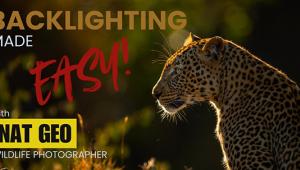Entry-Level Large Format
Starting Out Without Selling The Kids Page 2
You may find a used camera that is complete with lens or find you have to shop for a lens separately. Either way you want to keep a few things in mind. First, the normal lens for a 4x5 camera is around 150mm. This will give you approximately the same field of view as a 50mm lens on your 35mm SLR. What focal length you should look for depends on your personal needs, but most large format users start with a lens a bit longer than normal. A 210mm is the most common first lens, but you may prefer to stick with the 150mm focal length. Either way, I suggest you get just one lens and work with it until you fully understand its capabilities and shortcomings.
As with cameras, used lenses can be a bargain, I have several lenses in my 4x5 outfit and I bought most of them used. Be sure and check the shutter speeds for consistency and look closely at the glass for scratches, cleaning marks, or fungus. If you can't find a bargain lens, or would rather not buy used glass, check out Calumet's Caltar II Compact lenses. They offer 150mm and 210mm versions of these German optics and they are both excellent.
Important Accessories
Regardless of which camera type you decide on you'll need to accessorize.
First, you need film holders. Standard sheet film holders hold two sheets each
so a half dozen or so is a good start. You may prefer to use Kodak Readyload
or Fuji Quickload holders. These accept special film prepackaged in light-tight
envelopes. You only need one holder but the film itself is a bit more expensive.
After years of traveling with traditional sheet film holders and spending my
evenings perspiring in the bottom of my sleeping bag struggling to keep dust
out of the holders while I unloaded the day's shoot, I switched to Quick/Readyload
film and I'll never go back. By the way, you can also use rollfilm holders
on most large format cameras. Using 120 or 220 roll film reduces film and processing
costs while giving you most of the benefits of large format.
While some large format cameras can be handheld you really should have a sturdy
tripod. You may already have one that is adequate, but be careful, as you could
easily lose all of the quality advantage you're looking for if your tripod
is wobbly. You may also already own a light meter. If not, you can use another
camera with a built-in meter to make light readings and simply transfer the
settings or you can use the Sunny 16 Rule. For those of you not familiar with
the Sunny 16 Rule it's very simple. If you use your film's ISO as
your shutter speed, the correct f/stop will be f/16 in bright sunlight. For
example, with ISO 125 film you would use 1/125 at f/16 if your subject were
in bright sunlight. There are also various exposure calculators and charts based
on this rule of thumb that can be used as an alternate to buying a light meter.
 |
|
|
There are just a couple of other
things you'll need to complete your kit. A cable release and a focusing
cloth--any dark cloth will do. In fact, many photographers simply use a
jacket or sweater to block stray light while focusing on the ground glass. Speaking
of focusing, you'll want a loupe or magnifier for critical focusing. Something
in the four-power range will do, I actually use the same loupe I use for slide
editing. A case or backpack will complete your outfit and which you chose depends
on how much walking you intend to do. Just remember, Edward Weston once said,
"Nothing is photogenic more than a hundred yards from the car."
Well, you've got some decision making to do: monorail view camera, field
camera, or classic Graphic camera. Once that decision is made you'll want
to get some help understanding the new skills required. If you live in, or close
to, a big city check out the local colleges and adult schools. But, in case
you can't find any classes or workshops to attend I've included
a sidebar with some books you may find useful.
I first used a monorail camera in college where we were required to do all our
first semester projects utilizing the view camera and large format film. I can
still remember the thrill of looking for the first time at a 4x5 negative and
the incredible detail it contained. Printing those negatives was even more exciting.
While 35mm film is great, I love medium format and think digital is fantastic,
but if I could have only one camera it would have to be a 4x5.
An Ansel Adams Guide: Basic Techniques of Photography, Book 1; John P. Schaefer; Little Brown and Co., 1271 Avenue of the Americas, New York, NY 10020; ISBN 0-8212-1882-4; soft cover (also available hard cover); 432 pages; $35.
Kodak Book of Large Format Photography; Roger Vail; Silver Pixel Press, 21 Jet View Dr., Rochester, NY 14624; ISBN 0-87985-771-4; soft cover; 112 pages; $19.95.
Large Format Nature Photography; Jack Dykinga; Amphoto Books, 770 Broadway, New York, NY 10003; ISBN 0-8174-4157-3; soft cover; 144 pages; $29.95.
Photographing the Landscape; John Fielder; Westcliffe Publishers, Inc., PO Box 1261, Englewood, CO 80150; ISBN 1-56579-150-9; hard cover; 191 pages; $50.
View Camera Technique, 7th Edition; Leslie Stroebel; Focal Press, 200 Wheeler Rd., 6th Floor, Burlington, MA 01803; ISBN 0-240-80345-0; hard cover; 376 pages; $64.95.
Manufacturers/DistributorsBadger brand view cameras:
Badger Graphic Sales, Inc.
(920) 766-9332
www.badgergraphic.com
Calumet Cadet view cameras:
Calumet Photographic, Inc.
(800) 225-8638
www.calumetphoto.com
Gowland cameras:
Peter Gowland
(310) 454-7867
www.petergowland.com
Osaka cameras and lenses:
Bromwell Marketing
(412) 321-4118
www.bromwellmarketing.com
Tachihara cameras:
Adorama Camera, Inc.
(800) 223-2500
www.adorama.com
Toyo view cameras:
Mamiya America Corporation
(914) 347-3300
www.mamiya.com
- Log in or register to post comments
































